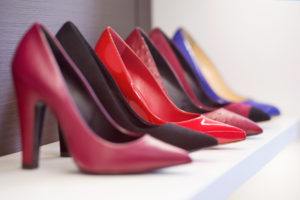 When was the last time you paid attention to your feet? Not the “Oh boy, I need a pedicure,” kind of attention, but real focus on how those feet of yours do the job of holding you up and walking (and running) you around in your world every day. Most people are pretty hard on their feet, and not many give their feet much love.
When was the last time you paid attention to your feet? Not the “Oh boy, I need a pedicure,” kind of attention, but real focus on how those feet of yours do the job of holding you up and walking (and running) you around in your world every day. Most people are pretty hard on their feet, and not many give their feet much love.
Think about the shoes you wear for a moment. Lots of women cram their feet into beautiful, fashionable, and physiologically challenging high-heeled shoes. Toes pressed and pinched into tight points, heels way up in the air, and very little support overall. The feet (and the body) are forced into a very unnatural position, creating an odd distribution of weight, which over time can contribute to all kinds of challenges for posture and movement.
“But wait!” you say. “I wear fabulous runners/trainers, with great arch support and scientifically designed cushioning! My feet are totally looked after!” And I’d say you’re right, your feet are “looked after.” You’re wearing race cars on your feet! But if they’re constantly in those shoes, your feet are now a little more like spoiled children than the workhorses they have to be to function well. Take you out of those shoes for any reason, and your body may not be able to replicate the support that those shoes gave you. And in those shoes, well, the parts of the body that depend on information from those non-functioning feet no longer get the information they need to do their jobs well. Over time, the dysfunction can move up and down the chain. Shin splints, hammer toes, bunions, ankle sprains, funky knees… Pay attention to your feet, and many of these sometimes painful conditions can be banished for good.
Some time ago, I worked with a young rugby player who struggled with recurring shin splints that were really beginning to affect his ability to play and train. I assessed his structure and his gait, and then asked him to take off his shoes and walk around for a few minutes. The problem became evident immediately. As he walked without his shoes, it looked as though he had bricks at the end of his legs. He stumped around the room, flat footed. Here was a skilled athlete who was unable to adopt a natural, functional gait pattern in bare feet. He was so used to runners, and cleats, that his feet and ankles had lost their ability to properly manage transfers of weight. The muscles in his feet and lower legs were not responding well to loading, (so his hip flexors were overactive too) and the stress of his movement was ending up in the long bones of his lower legs. Hence, the repeated shin splints. We did a lot of work mobilizing and strengthening his feet and ankles. We found ways for him to integrate that new strength and mobility up through his legs and pelvis and into his core. We explored strategies for movement while he was running – and particularly with quick changes of weight and direction. His shin splints became a thing of the past.
The feet are often viewed as the last link on a chain. Gravity draws the weight of the body downward; dragging the effects of all its postural oddities and mechanical compensations down the spine, through the pelvis, into the legs and through the feet into the floor. The feet manage the way in which the body relates to the ground. The feet make continuous small adjustments on uneven ground to keep you standing upright. The feet support and sling the weight of your body through their arches all day, every day. But the feet are also the first link on the chain. Your feet help you to move away from gravity by pushing back. They press the floor away with each step. In fact, if you pay attention as you walk, you’ll be able to feel that the lateral third of the foot is more the “weight bearing” edge, and the inside third of the foot is used more for propulsion. You want feet that can respond and react. You want feet that have strength and mobility to move and transfer weight efficiently. Tension, stiffness, weakness, imbalances and lack of mobility in the feet will compound any structural issues that may be going on higher up.
Do YOUR feet need more attention? Let’s just assume the answer is yes, because I have yet to meet anyone whose feet couldn’t use a little help. But another way you can tell is by looking at the wear on your shoes. Do the outsides of the heels on your shoes tend to wear out first? Do you always get holes under the big toes? You’ll probably notice some patterns. Pay attention to the patterns, and learn to strengthen and mobilize your feet to help your whole body move better. Here are three quick and easy ways to show your tootsies a little love.
1. Roll out your feet.Using a small rubber ball, roll out your feet. Place the ball on the floor and roll up and down the arches. Allow your weight to sink into whatever little pressure points you may find. Picture creating space for the bones. Work up and down the outer third of the foot, then the inner third, and then up and down the centre. Just for fun, before you roll out the other foot – take a little walk and feel the difference. What feels different? What feels the same? Can you feel difference in your sense of connection to the legs? Where is there ease?
 2. Spread Your Toes You know those little foam things you put between your toes when you’re giving yourself a pedicure? Grab a pair of those, put them on your feet and walk around the house barefoot for a while. If you’ve never done anything like this, start with about 5 – 10 minutes. If you’re a pro, you can walk around with them on for 30 minutes or more. Once you’ve had enough, take the foamies out, and notice how you feel. Do the feet feel wider, more spacious? Do you feel a little more grounded through your legs? Where can you feel ease?
2. Spread Your Toes You know those little foam things you put between your toes when you’re giving yourself a pedicure? Grab a pair of those, put them on your feet and walk around the house barefoot for a while. If you’ve never done anything like this, start with about 5 – 10 minutes. If you’re a pro, you can walk around with them on for 30 minutes or more. Once you’ve had enough, take the foamies out, and notice how you feel. Do the feet feel wider, more spacious? Do you feel a little more grounded through your legs? Where can you feel ease?
3. Stretch & RiseStand on the edge of a step, feet parallel, with the only the toes & balls of your feet on the step . Use a banister or the wall for balance. Keeping your legs long, spread the balls of the feet wide, and lower your heels below the level of the step. Make sure your knees face straight ahead, without locking them back. You’ll probably feel a nice little stretch in your calves. Feel the width of your heels, and allow the heel bones to hang, almost as though they are dew drops ready to melt off your feet. Keep a sense of the hang of the heel and the spread of the balls of the feet, press up to a rise – lengthening the inner legs at the same time. The heels will lift up – but for the purpose of this exercise, you don’t want to feel as though they are driving the action. (If you lengthen your spine and gently activate your core, this will feel even better. Just don’t clench your butt or tuck your tail.) Maintain a feeling of length in the inner legs and lateral hips, and slowly lower the heels back down. Keep seeking length & width through the balls of the feet. Repeat this 10 or 15 times.
Massage them, pamper them, love them up. Your feet deserve all the care you can give them. They’ve been holding you up and moving you around since the day you learned how to walk. And you don’t often hear them complain. But give them a little care and attention, and you’ll find they start giving back – your movement will feel easier and you’ll re-discover a spring in your step.
